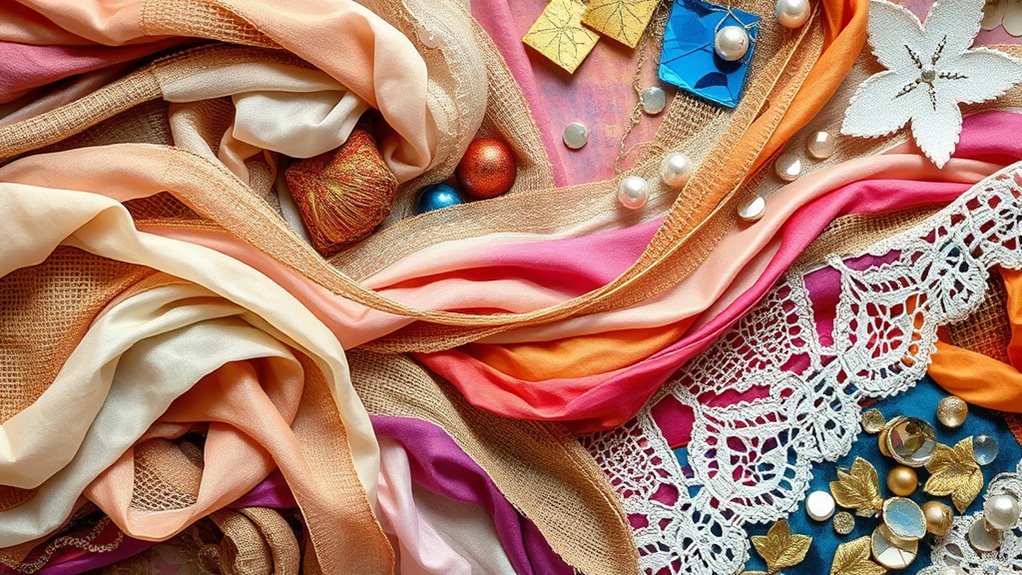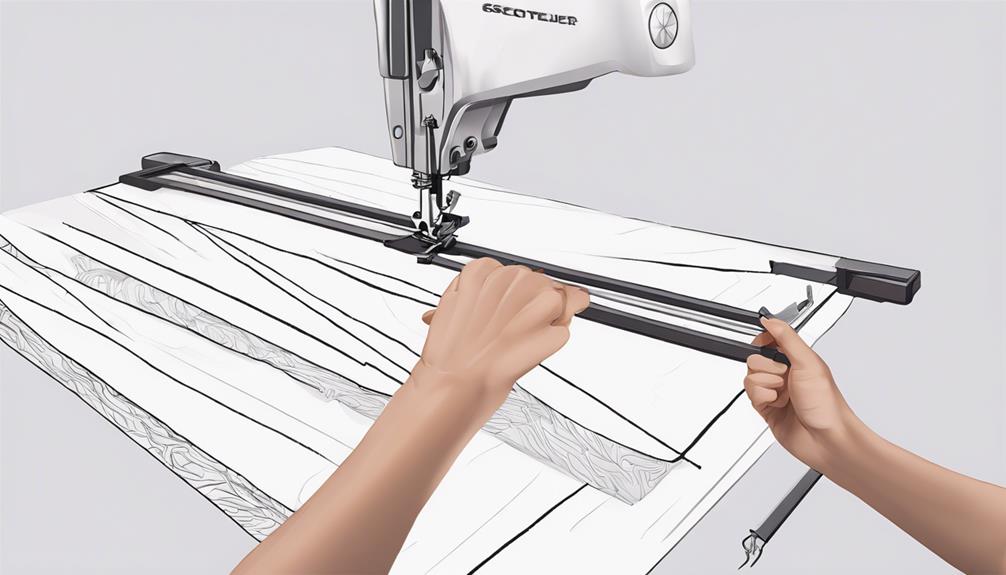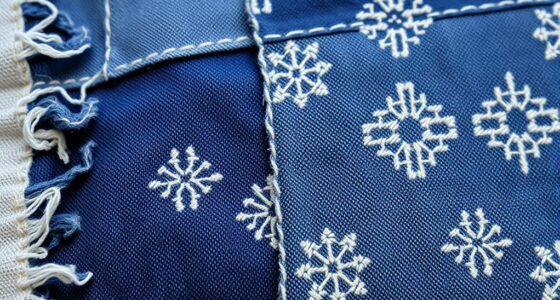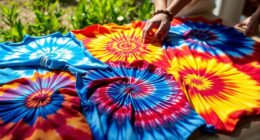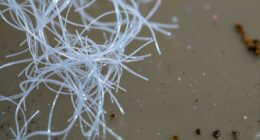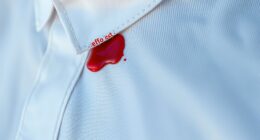Mixed media masterpieces often combine textiles with other art forms to create immersive, tactile experiences. By integrating fabrics, fibers, and traditional textile techniques like embroidery, quilting, or fabric collage, artists add depth, texture, and emotional impact. These elements work alongside sculpture, digital media, or painting to produce vibrant, layered artworks that engage both sight and touch. If you keep exploring, you’ll discover how these innovative combinations transform artistic expression and captivate viewers in unexpected ways.
Key Takeaways
- Artists integrate textiles with painting, sculpture, and digital media to create immersive, multidimensional artworks.
- Textile techniques like embroidery and fabric collage add tactile depth and visual complexity to mixed media pieces.
- Combining textiles with other materials enhances emotional expression and cultural storytelling in art installations.
- Digital technologies such as projection mapping and data verification link textiles with interactive multimedia elements.
- The fusion of textiles with various art forms broadens creative possibilities, resulting in vibrant, layered masterpieces.
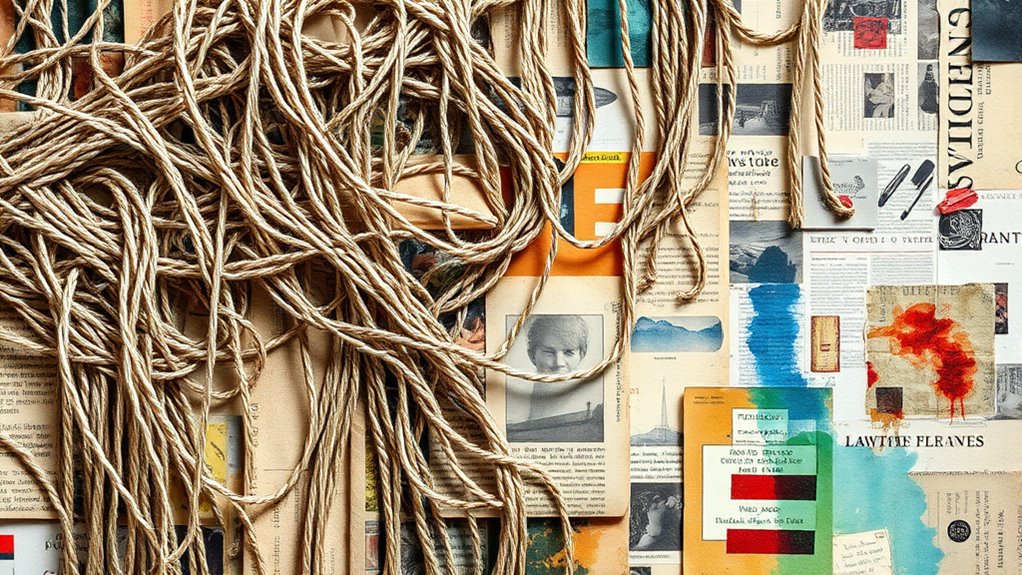
Have you ever wondered how artists blend different materials to create dynamic, textured artworks? The magic lies in their mastery of textile techniques, which they skillfully incorporate into diverse art installation projects. These techniques allow artists to transform ordinary fabrics and fibers into compelling visual narratives, adding depth and tactile richness to their pieces. When you explore mixed media art, you’ll see how textiles aren’t just background elements—they’re active components that interact with other mediums like paint, sculpture, or digital media. By combining textiles with various art forms, artists craft immersive experiences that engage both sight and touch, inviting viewers to step closer and feel the textures.
Textiles transform art by adding tactile depth and dynamic interaction across diverse media and installations.
In an art installation, textile techniques serve as the foundation for building layered, multidimensional environments. Artists often use fabric manipulation methods such as quilting, weaving, embroidery, or fabric collage to construct the core structure. These techniques enable them to create intricate surfaces that mimic natural textures or abstract patterns, offering a sensory dimension to the installation. For example, a large-scale textile piece might feature stitched patterns that protrude from the surface, giving it a tactile quality that encourages viewers to explore with their hands. Incorporating textiles into art installations also provides flexibility; fabrics can be draped, stretched, or sewn into complex forms, forming expansive sculptures or immersive environments that challenge traditional boundaries of art.
Furthermore, textile techniques are incredibly adaptable, allowing artists to fuse textiles seamlessly with other materials like wood, metal, or digital media. This integration results in layered compositions that evoke emotion and provoke thought. For instance, an art installation might combine woven textiles with projection mapping or lighting to create shifting visual sensations, enhancing the depth and interactivity of the piece. The tactile nature of textiles also offers a visceral connection that can evoke memories, cultural heritage, or social commentary. Additionally, Merkle trees can be employed in digital art components to verify data integrity within multimedia installations, linking traditional textile techniques with modern technological concepts. By thoughtfully applying textile techniques, artists craft works that are not only visually striking but also emotionally resonant.
Ultimately, understanding textile techniques and their role in art installations reveals a new appreciation for mixed media art. It demonstrates how fabric and fiber can transcend their traditional roles and become essential elements in contemporary artistic expression. Whether it’s through intricate embroidery, layered fabric collages, or innovative textile sculptures, these techniques enable artists to push creative boundaries and produce artworks that are vibrant, textured, and full of life. As you explore mixed media masterpieces, you’ll see firsthand how textiles—when skillfully employed—can bridge different art forms and shape immersive, thought-provoking experiences for viewers.
Frequently Asked Questions
What Are the Best Tools for Combining Textiles With Other Media?
To combine textiles with other media effectively, you’ll want fabric adhesives for secure, seamless joins, and digital embroidery software to add intricate designs. Fabric adhesives make attaching different materials easy, while digital embroidery software helps you create detailed patterns that blend well with your textiles. Using these tools, you can experiment freely, achieving professional-looking mixed media artwork that beautifully integrates various textures and media.
How Can I Preserve Mixed Media Textile Artworks Long-Term?
Preserve your mixed media textile artworks as if safeguarding treasured stories. You should use proper framing techniques, like UV-protective glass and acid-free mounts, to shield from light and pollutants. Keep them away from environmental factors such as humidity, temperature fluctuations, and direct sunlight. Regularly inspect and gently clean the pieces. This careful approach guarantees your masterpieces remain vibrant, telling their story for generations to come.
Are There Specific Techniques for Integrating Textiles Into Digital Art?
Yes, you can integrate textiles into digital art using techniques like fiber layering and digital embroidery. You’ll start by creating layered textile textures that add depth, then incorporate digital embroidery to enhance detail and precision. These techniques allow you to blend traditional textile elements with digital tools seamlessly, resulting in rich, tactile artworks. Experimenting with fiber layering and digital embroidery helps you achieve innovative, hybrid art pieces that stand out visually and texturally.
What Are Common Challenges Faced When Merging Textiles With Sculpture?
When merging textiles with sculpture, you might face challenges like fabric fragility, which can cause tears or deformities over time. Color bleeding is another issue, especially with dyes that aren’t colorfast, risking staining your sculpture. To overcome these problems, you should choose durable fabrics, use proper sealing techniques, and test colorfastness beforehand. These steps help guarantee your mixed media sculpture remains stable and vibrant for years to come.
How Can I Incorporate Textiles Into Interactive or Wearable Art Projects?
Did you know that 65% of wearable tech designs now integrate textiles for both function and storytelling? To incorporate textiles into interactive or wearable art, focus on textile storytelling by using fabrics that convey emotion or narrative. Combine this with wearable technology like embedded sensors or LED lights to enhance interactivity. This approach creates dynamic pieces that engage viewers and wearers, making your art truly innovative and personal.
Conclusion
As you explore mixed media masterpieces, you realize they’re like vibrant tapestries woven from diverse threads of creativity. Combining textiles with other art forms sparks innovation and depth, turning simple materials into enthralling stories. Just as a garden blooms with a variety of flowers, these artworks flourish through their blend of textures and techniques. Embrace the versatility and let your imagination run wild—your own mixed media masterpiece awaits, waiting to bloom into something extraordinary.

